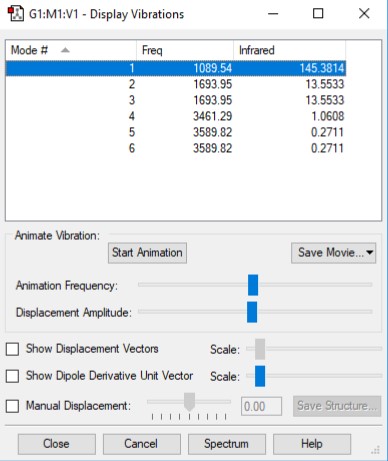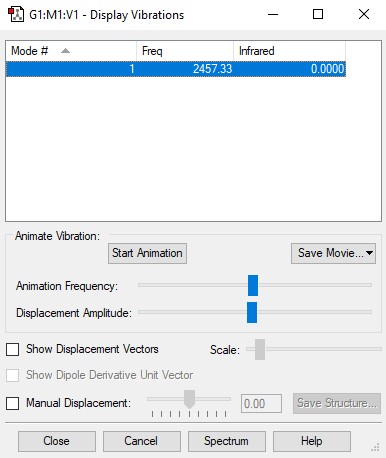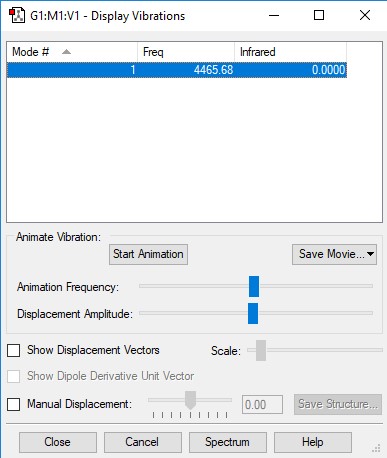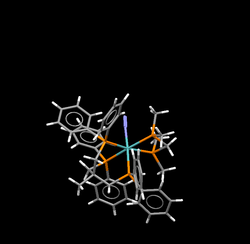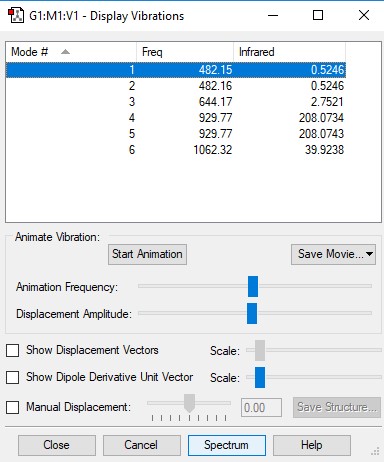PG12138
NH3
Basic information
Calculation method: B3LYP
Basis set: 6-31G(d,p)
Charge: 0
RMS gradient norm : 0.00000485 a.u.
Final energy in atomic units: -56.49570525a.u.
Point group:C3v
Item table
Item Value Threshold Converged?
Maximum Force 0.000004 0.000450 YES RMS Force 0.000004 0.000300 YES Maximum Displacement 0.000072 0.001800 YES RMS Displacement 0.000035 0.001200 YES Predicted change in Energy=-5.986279D-10 Optimization completed.
JSmol image and link
NH3 |
Bond diatance and bond angle
Bond distance: 1.02Å
Bond angle: 105.7 degree
Vibration table
| wavenumber/cm-1 | 1090 | 1694 | 1694 | 3461 | 3590 | 3590 |
|---|---|---|---|---|---|---|
| symmetry | A1 | E | E | A1 | E | E |
| intensity | 145 | 14 | 14 | 1 | 0 | 0 |
NBO charge
NBO Charge: i would expect a positive charge on the H atom and a negative charge on the N atom becuse N is more electronegative than H. The resilts shows that H atom has a charge of 0.375 and N atom has a charge of -1.125.
Questions
how many modes do you expect from the 3N-6 rule? 6 modes
which modes are degenerate (ie have the same energy)? 1694 cm-1 and 3590 cm-1
which modes are "bending" vibrations and which are "bond stretch" vibrations? 1090cm-1,1649cm-1 and 1649cm-1 are bending. 3461cm-1,3590cm-1 and 3590cm-1 are streching.
which mode is highly symmetric? 3461cm-1
one mode is known as the "umbrella" mode, which one is this? 1090cm-1 and 3461cm-1
how many bands would you expect to see in an experimental spectrum of gaseous ammonia? 4 bands
N2 and H2
N2
Basic information
Calculation method: B3LYP
Basis set: 6-31G(d,p)
Charge: 0
RMS gradient norm: 0.00000060a.u.
Final energy in atomic units: -56.49570525a.u.
Point group:D*H
Item table
Item Value Threshold Converged? Maximum Force 0.000001 0.000450 YES RMS Force 0.000001 0.000300 YES Maximum Displacement 0.000000 0.001800 YES RMS Displacement 0.000000 0.001200 YES Predicted change in Energy=-3.400985D-13 Optimization completed.
JSmol image and link
N2 |
Bond distance and bond angle
Bond distance:1.10550Å
Bond angle:180 degree
Vibration table
| wavenumber/cm-1 | 2457 |
|---|---|
| symmetry | SGG |
| intensity | 0 |
NBO charge
NBO charges: I would expect zero charge on both N atoms as there is no electronegativity difference bewteen the two bonded N atoms. The calculation results also shows that the charge on both N atoms are 0.000.
H2
Basic information
Calculation method: B3LYP
Basis set: 6-31G(d,p)
Charge: 0
Final energy in atomic units: -56.49570525a.u.
RMS gradient norm: 0.0000017
Point group:D*H
Item table
Item Value Threshold Converged? Maximum Force 0.000000 0.000450 YES RMS Force 0.000000 0.000300 YES Maximum Displacement 0.000000 0.001800 YES RMS Displacement 0.000001 0.001200 YES Predicted change in Energy=-1.164080D-13 Optimization completed.
JSmol image and link
H2 |
Bond distance and bond angle
Bond distance:0.74279Å
Bond angle: 180 degrees
Vibration table
| wavenumber/cm-1 | 4466 |
|---|---|
| symmetry | SGG |
| intensity | 0 |
NBO charge
NBO charges: same as N2 molecule, there is no electronegativity difference between the two bonded H atoms so the charges should be zero. The results also shows that the charges on both H atoms are 0.000.
HAJSOC
This is the link to HAJSOC[1]
The N-N triple bond in HAJSOC is 1.069 and the bond of N2 molecule is 1.10550 which is different from the one in HAJSOC. This could possible due to the presence of the transition metal. The hybridization of the metal is involved in the o-interaction of the N-N triple bond so the bond length changes.
Energy of the reaction
E(NH3)= -56.55776873 a.u.
2*E(NH3)= -113.1155375 a.u.
E(N2)= -109.52412868 a.u.
E(H2)= -1.17853936 a.u.
3*E(H2)= -3.53561808 a.u.
ΔE=2*E(NH3)-[E(N2)+3*E(H2)]= -0.05579074 a.u.= -146.8 kJ/mol
NF3
Basic information
Calculation method: B3LYP
Basis set: 6-31G(d,p)
Charge: 0
Final energy in atomic units: -56.49570525a.u.
RMS graident norm: 0.00010256
Point group:C3v
Item table
Item Value Threshold Converged?
Maximum Force 0.000164 0.000450 YES
RMS Force 0.000108 0.000300 YES
Maximum Displacement 0.000612 0.001800 YES
RMS Displacement 0.000296 0.001200 YES
Predicted change in Energy=-1.274067D-07
Optimization completed.
-- Stationary point found.
----------------------------
! Optimized Parameters !
! (Angstroms and Degrees) !
-------------------------- --------------------------
! Name Definition Value Derivative Info. !
--------------------------------------------------------------------------------
! R1 R(1,2) 1.384 -DE/DX = 0.0 !
! R2 R(1,3) 1.384 -DE/DX = 0.0 !
! R3 R(1,4) 1.384 -DE/DX = 0.0 !
! A1 A(2,1,3) 101.8302 -DE/DX = 0.0001 !
! A2 A(2,1,4) 101.8302 -DE/DX = 0.0002 !
! A3 A(3,1,4) 101.8302 -DE/DX = 0.0002 !
! D1 D(2,1,4,3) -104.9443 -DE/DX = -0.0001 !
--------------------------------------------------------------------------------
GradGradGradGradGradGradGradGradGradGradGradGradGradGradGradGradGradGrad
JSmol image and link
File:BL1718 NF3.LOG
NF3 |
Bond distance and bond angle
Bond distance: 1.38404Å Bond angle: 101.830 degree
Vibration table
| wavenumber/cm-1 | 482 | 482 | 644 | 930 | 930 | 1062 |
|---|---|---|---|---|---|---|
| symmetry | E | E | A1 | E | E | A1 |
| intensity | 1 | 1 | 3 | 208 | 208 | 40 |
NBO charge
NBO charges: the F atom is more electronegative than N atom so i would expect there is a positive charge on the central N atom and a negative charge on each F atom. The result shows that there is a charge of 0.660 on the central N atom and a charge of -0.220 on the F atoms.
Molecular modeling
Marking
Note: All grades and comments are provisional and subjecct to change until your grades are officially returned via blackboard. Please do not contact anyone about anything to do with the marking of this lab until you have recieved your grade from blackboard.
Wiki structure and presentation 1/1
Is your wiki page clear and easy to follow, with consistent formatting?
YES
Do you effectively use tables, figures and subheadings to communicate your work?
YES
NH3 0.5/1
Have you completed the calculation and given a link to the file?
YES
Have you included summary and item tables in your wiki?
YES
Have you included a 3d jmol file or an image of the finished structure?
YES
Have you included the bond lengths and angles asked for?
YES
Have you included the “display vibrations” table?
YES
Have you added a table to your wiki listing the wavenumber and intensity of each vibration?
YES
Did you do the optional extra of adding images of the vibrations?
YES
Have you included answers to the questions about vibrations and charges in the lab script?
YES - You correctly stated that there are two sets of degenerate modes - this explains a spectrum with 4 peaks. However there are only 2 peaks visible as peaks 4, 5 and 6 are of too low an intensity to be visible. Additionally the umbrella mode is the one at 1090cm-1 and not at 3461cm-1.
N2 and H2 0/0.5
Have you completed the calculations and included all relevant information? (summary, item table, structural information, jmol image, vibrations and charges)
YES - however, you stated a bond angle for diatomic molecules. To define a bond angle a minimum of 3 atoms is needed!
Crystal structure comparison 0.5/0.5
Have you included a link to a structure from the CCDC that includes a coordinated N2 or H2 molecule?
YES
Have you compared your optimised bond distance to the crystal structure bond distance?
YES
Haber-Bosch reaction energy calculation 0.5/1
Have you correctly calculated the energies asked for? ΔE=2*E(NH3)-[E(N2)+3*E(H2)]
YES
Have you reported your answers to the correct number of decimal places?
YES
Do your energies have the correct +/- sign?
YES
Have you answered the question, Identify which is more stable the gaseous reactants or the ammonia product?
NO - you missed to interpret the value of the calculated reaction energy.
Your choice of small molecule 3.5/5
Have you completed the calculation and included all relevant information?
YES
Have you added information about MOs and charges on atoms?
You have done a good job of presenting this information, well done! You should have commented on the computed modes (degeneracy, how many modes you expected, how may bands will be seen in an experimental spectrum....) You missed to comment on the MOs being occupied/unoccupied. You missed to give the contributing AOs for the HOMO and LUMO and to state if they are bonding/anti-bonding or non-bonding. The first and third orbitals are not an anti-bonding orbitals. A node does not necessarily mean the MO is an anti-bonding one.
Independence 0/1
If you have finished everything else and have spare time in the lab you could: Check one of your results against the literature, or Do an extra calculation on another small molecule, or Do some deeper analysis on your results so far
NO - No independent work has been identified.

